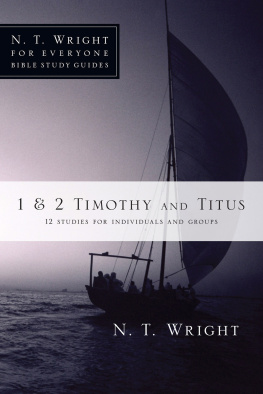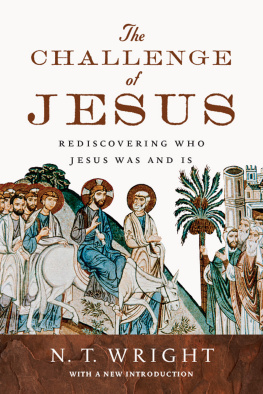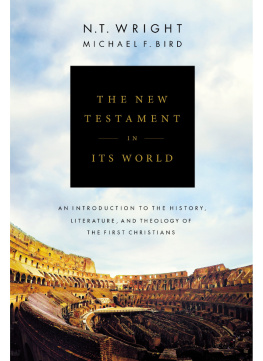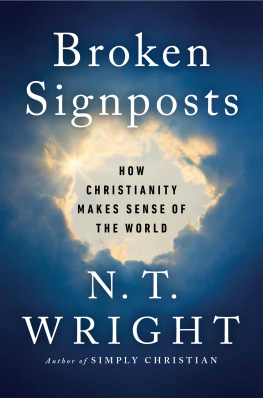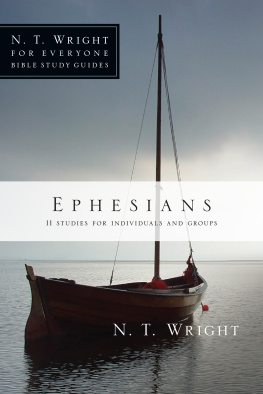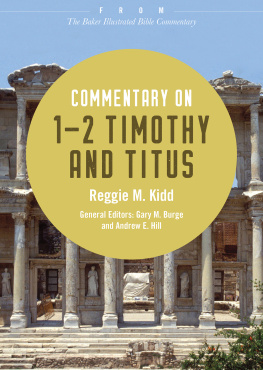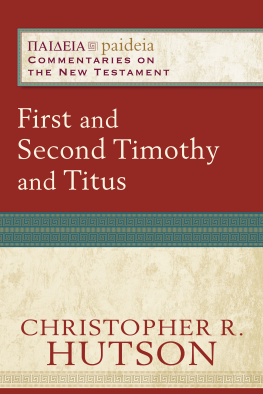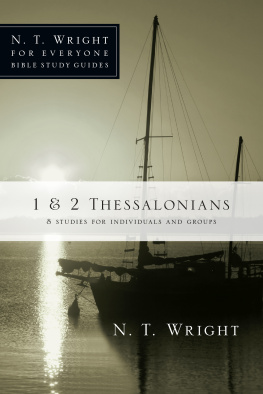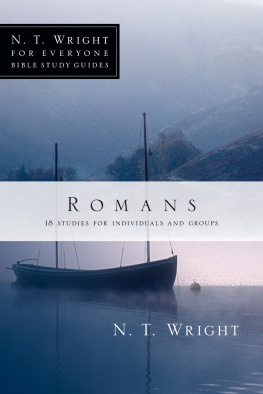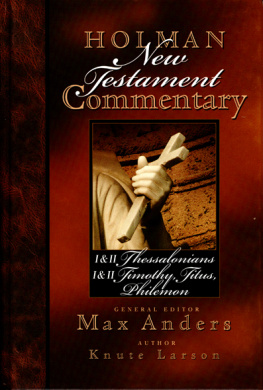N. T. WRIGHT
WITH PHYLLIS J. LE PEAU
All rights reserved. No part of this book may be reproduced in any form without written permission from InterVarsity Press.
This study guide is based on and includes excerpts adapted from Paul for Everyone: The Pastoral Letters, 2003, 2004 Nicholas Thomas Wright. All Scripture quotations, unless otherwise indicated, are taken from the New Testament for Everyone. Copyright 2001-2008 by Nicholas Thomas Wright. Used by permission of SPCK, London. All rights reserved.
GETTING THE MOST
OUT OF 1 & 2 TIMOTHY AND TITUS
Taken together, 1 and 2 Timothy and Titus are usually called the Pastoral Letters, partly because Paul is acting as a pastor to Timothy and Titus, and partly because he is writing to instruct them in their own pastoral ministries and in the ministries that they are to establish in their various congregations. But they might equally be called the Teachers Manual, because so much of what they contain is about the kind of teaching that Christian leaders should be givingand, just as much, the kind they shouldnt.
These letters are concerned with two types of teaching. We shall see Paul come back to them from several different angles in these three letters. One type of teaching, which he warns against, goes round and round in circles, picking up interesting ideas and theories and playing with them endlessly. This leads to confusion with no clear understanding or guidance. The other has a clear aim, cuts out anything that gets in the way of it and goes straight to the point.
The teaching of the gospel itself, and of the way of life which flows from it, must not be a muddled, rambling thing, going this way and that over all kinds of complex issues. It must go straight to the point and make it clearly, so that the young Christians who so badly need building up in their faith may learn the deep, rich, basic elements of Christian teaching. These are what make genuine Christianity stand out from the world around it, and they should not be hidden under a thick casing of complex and impenetrable ideas.
We are told clearly that the teaching in these letters does not aim at just conveying information, but a whole way of life summed up in 1 Timothy 1:5one of love, which comes from a pure heart and a good conscience and a sincere faith.
Underneath these we can detect two concerns which run through these letters. First, Paul is anxious that everyone who professed Christian faith should allow the gospel to transform the whole of their lives, so that the outward signs of the faith express a living reality that comes from the deepest parts of the personality. Second, he is also anxious that each Christian, and especially every teacher of the faith, should know how to build up the community in mutual love and support rather than, by the wrong sort of teaching or behavior, tearing it apart.
We know even today, with two thousand years of history, how easily things can seem to fall apart. As we study through this guide (prepared with the help of Phyllis Le Peau, for which I am grateful) we will see how much more fragile the little churches must have seemed in those early days, with tiny communities facing huge problems.
But, as the opening greeting insists, they do not face those problems alone and neither do we. As was true for Pauls apostleship, our ministry and life in Christ are rooted in Gods command. (For more background and reflection on these letters see my Paul for Everyone: The Pastoral Letters, on which this guide is based, published by SPCK and Westminster John Knox.)
As we study 1 and 2 Timothy and Titus, we too can be assured, even as Paul assured Timothy, of Gods grace, mercy and peace.
SUGGESTIONS FOR INDIVIDUAL STUDY
1. As you begin each study, pray that God will speak to you through his Word.
2. Read the introduction to the study and respond to the Open question that follows it. This is designed to help you get into the theme of the study.
3. Read and reread the Bible passage to be studied. Each study is designed to help you consider the meaning of the passage in its context. The commentary and questions in this guide are based on my own translation of each passage found in the companion volume to this guide in the For Everyone series on the New Testament (published by SPCK and Westminster John Knox).
4. Write your answers to the questions in the spaces provided or in a personal journal. Each study includes three types of questions: observation questions, which ask about the basic facts in the passage; interpretation questions, which delve into the meaning of the passage; and application questions, which help you discover the implications of the text for growing in Christ. Writing out your responses can bring clarity and deeper understanding of yourself and of Gods Word.
5. Each session features selected comments from the For Everyone series. These notes provide further biblical and cultural background and contextual information. They are designed not to answer the questions for you but to help you along as you study the Bible for yourself. For even more reflections on each passage, you may wish to have on hand a copy of the companion volume from the For Everyone series as you work through this study guide.
6. Use the guidelines in the Pray section to focus on God, thanking him for what you have learned and praying about the applications that have come to mind.
SUGGESTIONS FOR GROUP MEMBERS
1. Come to the study prepared. Follow the suggestions for individual study mentioned above. You will find that careful preparation will greatly enrich your time spent in group discussion.
2. Be willing to participate in the discussion. The leader of your group will not be lecturing. Instead, she or he will be asking the questions found in this guide and encouraging the members of the group to discuss what they have learned.
3. Stick to the topic being discussed. These studies focus on a particular passage of Scripture. Only rarely should you refer to other portions of the Bible or outside sources. This allows for everyone to participate on equal ground and for in-depth study.

